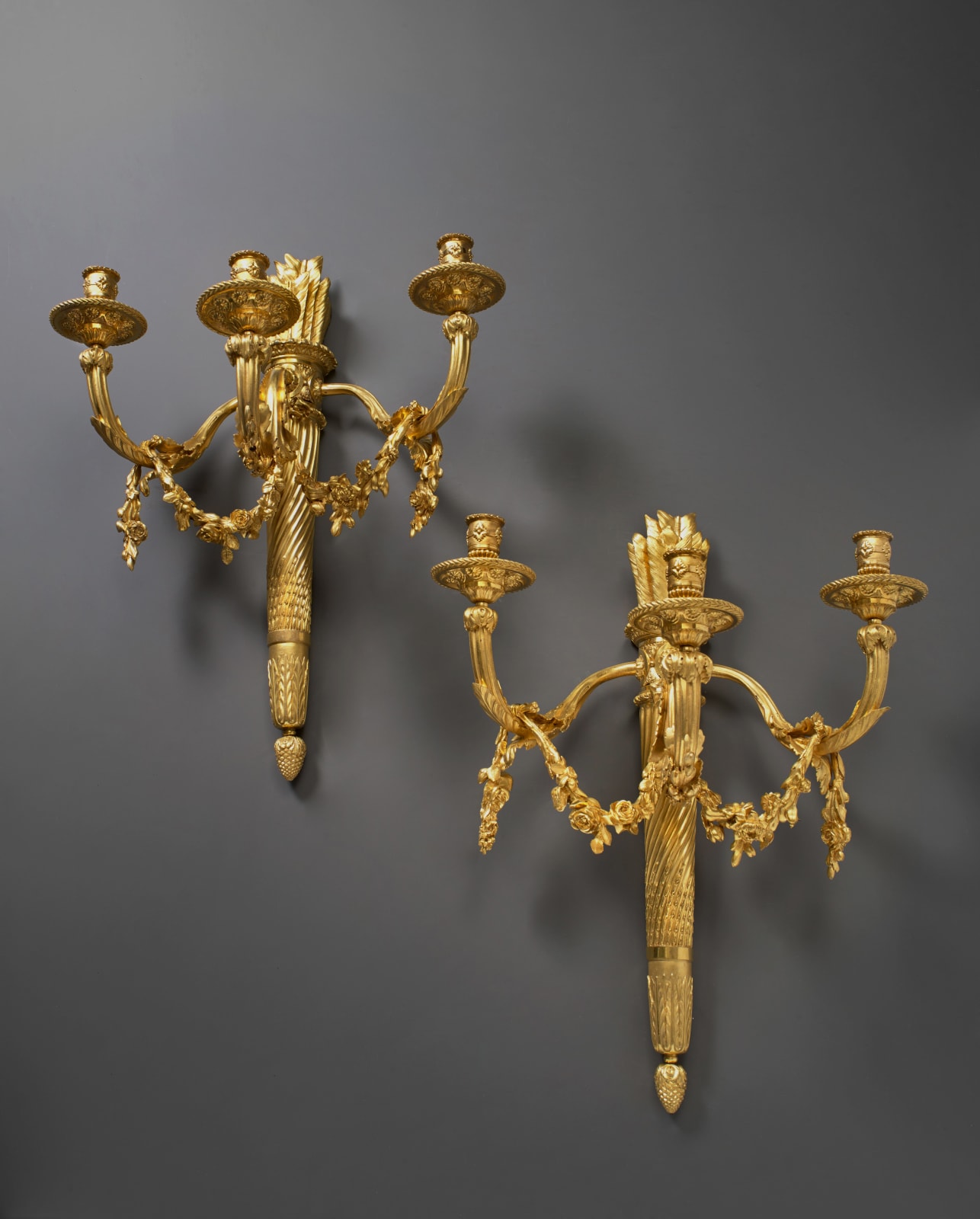Unknown
Literature
Geoffrey de Bellaigue, “The James A. de Rothschild Collection at Waddesdon Manor”, 1974, vol. II, p. 807, no. 223, illustrating one of a pair of comparable three-light gilt bronze wall-lights in the Waddesdon Collection.
A superb pair of Louis XVI gilt bronze three-light wall-lights, each with a part spiral fluted tapering backplate formed as a quiver terminating in a palm leaf calyx above a seed pod boss, the quiver-shaped backplate filled with arrow feathers above three foliate-wrapped scrolled and fluted candle branches terminating in circular drip-pans below a gadrooned and rosette mounted nozzle, each candle branch issuing from a sunflower within a circular border and hung with a bountiful rose and foliate swag that is gathered by a ribbon-tied pull attached to the top of the backplate
Paris, date circa 1785-90
Height 60 cm, width 47 cm. each.
These extremely beautiful wall-lights bear close comparison to a pair of wall-lights now at Waddesdon Manor that were originally one of three pairs made for Queen Marie-Antoinette’s apartments at Château de Compiègne. Although the latter are more elaborate, like the present pair they are cast and chaste in the form of a quiver of arrows and in particular the quiver and seed pod boss are of almost identical form and decoration. Likewise, the three acanthus-wrapped branches belonging to the wall-lights made for Marie-Antoinette are more abundantly adorned with further scrolls and rosettes as well as berried, fruiting and flowering swags, nevertheless they are of the same overall form as here and seemingly issue from sunflowers at the top of the quiver. In essence the overall form and decorations are the same yet here each element is simpler. Given their similarity, it likely that the present pair of wall-lights was inspired by those made for Marie-Antoinette at Château de Compiègne.
The three pairs of wall-lights made for Louis XVI’s wife were supplied in 1787 for the Salon des Jeux. Made from a wood and wax model by Martin (possibly Gilles-François Martin, c. 1713-95), under the direction of the sculptor Jean Hauré (fl. 1774-post 1796), they were either cast by Etienne-Jean Forestier (maître 1764) or his brother Pierre-Auguste Forestier (1755-1835) and then chased by the fondeur-ciseleur Pierre-Philippe Thomire (1751-1843). The other two pairs were later moved to Château de Fontainebleau but more recently have been reinstated in Marie-Antoinette’s Salon de Jeux at Compiègne. A further two pairs, possibly made at the same time but more likely slightly later than Marie-Antoinette’s are in the Wallace Collection (illustrated and discussed in Peter Hughes, “The Wallace Collection Catalogue of Furniture”, 1996, pp. 1426-1430, no. 300, F366-9). Hughes notes that they too were probably made by Forestier and Thomire after the original model which was still in store of the Garde-Meuble de la Couronne in 1790 but was then sold in 1797 during the later years of the French Revolution.
The overall theme of a quiver of arrows accorded well with the Neo-classical style during the Louis XVI period. In particular, they relate to Cupid, Venus’s attendant who according to mythology was often shooting his arrows at prospective lovers.
